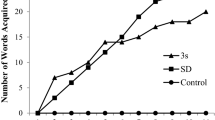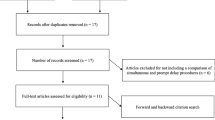Abstract
The current two-experiment study examined the effects of a regressive prompt-delay procedure on sight-word reading of four elementary school students. In contrast to traditional progressive prompt-delay procedures in which the latency of prompts is increased, the regressive prompt-delay latency is decreased over time. Data indicate that participants learned sight words quickly and maintained responding at high levels when instruction was withdrawn across both regressive and progressive prompt-delay conditions. Results are discussed in context of empirically supported prompting strategies and possible motivating operations that might be introduced when the learner is instructed to respond more quickly than the experimenter in regressive prompt delay (e.g., a game-like activity that potentially makes the activity educational, engaging, and enjoyable for students).


Similar content being viewed by others
References
Browder, D. H., Wakeman, S. Y., Spooner, F., Ahlgrim-Delzell, L., & Algozzine, B. (2006). Research on reading instruction for individuals with significant cognitive disabilities. Exceptional Children, 72, 392–408.
Daly, E. J, I. I. I., Martens, B. K., Skinner, C. H., & Noell, G. H. (2009). Contributions of applied behavior analysis. In T. B. Gutkin & C. R. Reynolds (Eds.), The handbook of school psychology (4th ed., pp. 84–106). New York, NY: Wiley.
Daly, E. J, I. I. I., Witt, J. C., Martens, B. K., & Dool, E. J. (1997). A model for conducting a functional analysis of academic performance problems. School Psychology Review, 26, 554–574.
Everett, G. E., & Edwards, R. P. (2007). Targeting subtraction inversion errors through within-stimulus prompting: A case study. Psychology Journal, 4, 128–139.
Fry Word List—1,000 High Frequency Words. (2008). Retrieved from http://www.k12reader.com/fry-word-list-1000-high-frequency-words/.
Kupzyk, S., Daly, E. J, I. I. I., & Andersen, M. N. (2011). A comparison of two flash-card methods for improving sight word reading. Journal of Applied Behavior Analysis, 44, 781–792. doi:10.1901/jaba.2011.44-781.
McComas, J., Hoch, H., Paone, D., & El-Roy, D. (2000). Escape behavior during academic tasks: A preliminary analysis of idiosyncratic establishing operations. Journal of Applied Behavior Analysis, 33, 479–493.
Michael, J. (1982). Distinguishing between discriminative and motivational functions of stimuli. Journal of the Experimental Analysis of Behavior, 37, 149–155.
Moseley, D., & Poole, S. (2001). The advantages of rime-prompting: A comparative study of prompting methods when hearing children read. Journal of Research in Reading, 24, 163.
Park, C., Weber, K. P., & McLaughlin, T. F. (2007). The effects of fading, modeling, prompting, and direct instruction on letter legibility for two preschool students with physical and developmental delays. Child & Family Behavior Therapy, 29, 13–21.
Parrott, K. A., Schuster, J. W., Collins, B. C., & Gassaway, L. J. (2000). Simultaneous prompting and instructive feedback when teaching chained tasks. Journal of Behavioral Education, 10, 3–19.
Pennington, R. C., Stenhoff, D. M., Gibson, J., & Ballou, K. (2012). Using simultaneous prompting to teach computer-based story writing to a student with autism. Education & Treatment of Children, 35, 389–406.
Reichow, B., & Wolery, M. (2011). Comparison of progressive prompt delay with and without instructive feedback. Journal of Applied Behavior Analysis, 44, 327–340.
Schuster, J. W., Gast, D. L., Wolery, M., & Guiltinan, S. (1988). The effectiveness of a constant time-delay procedure to teach chained responses to adolescents with mental retardation. Journal of Applied Behavior Analysis, 21, 169–178. doi:10.1901/jaba.1988.21-169.
Sidman, M. (1960). Tactics of scientific research: Evaluating experimental data in psychology. New York: Basic Books.
Smith, R. G., & Iwata, B. A. (1997). Antecedent influences on behavior disorders. Journal of Applied Behavior Analysis, 30, 343–375.
Touchette, P. E. (1971). Transfer of stimulus control: Measuring the moment of transfer. Journal of the Experimental Analysis of Behavior, 15, 347–354.
Walker, G. (2008). Constant and progressive time delay procedures for teaching children with autism: A literature review. Journal of Autism and Developmental Disorders, 38, 261–275.
Author information
Authors and Affiliations
Corresponding author
Rights and permissions
About this article
Cite this article
Daly, E.J., Hess, P.M., Sommerhalder, M. et al. Examination of a Regressive Prompt-Delay Procedure for Improving Sight-Word Reading. J Behav Educ 25, 275–289 (2016). https://doi.org/10.1007/s10864-016-9245-4
Published:
Issue Date:
DOI: https://doi.org/10.1007/s10864-016-9245-4




